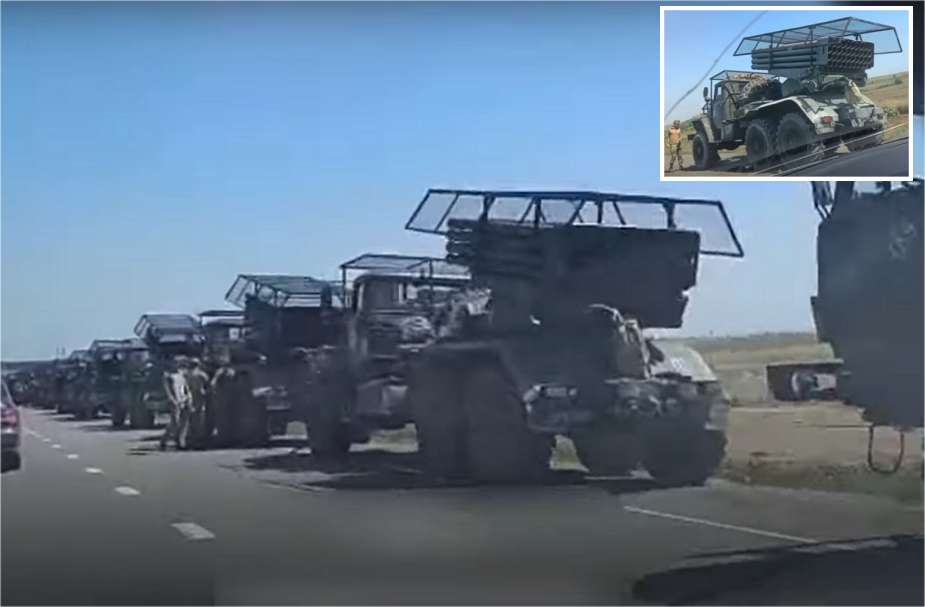- Army
- Conflicts in the world
- Israel - Iran conflict 2025
- Pakistan - India Conflict 2025
- Russia Ukraine War 2022
- Libya conflict day by day
- HAMAS - Israel War 2023
- Operation Serval in Mali French Army
- Sangaris operation Central African Republic
- Sangaris opération militaire République Centreafrique
- Ukraine - Russia conflict
- Syria conflict news
- Defence & Security Industry Technology
- Armies in the world
- Analysis Defense and Security Industry
- Conflicts in the world
- Navy
- Air
16 BM-21 Grad MLRS equipped with anti-drone grilles spotted in Russia
According to a video from the Telegram channel Atesh, which monitors the movement of military equipment on the territory of the Russian Federation, a column of 16 BM-21 Grad multiple rocket launcher systems (MLRS) equipped with protective grilles was spotted at the entrance to the city of Kamyshin, Volgograd region. Most likely, these vehicles will be sent to war in Ukraine, each fitted with these trapezoid-shaped grilles.
Follow Army Recognition on Google News at this link

A column of 16 BM-21 Grad was spotted in Russia, fitted with anti-drone grilles (Picture source: Telegram and Yandex)
On top of the tube launchers, both the cabin roof and the engine hood of the trucks are surmounted by slat grilles. It's suggested that these modifications are intended to protect the artillery units from potential threats posed by FPV drones or copters capable of dropping munitions.
The rise in the use of protective grilles on military hardware is largely a response to the growing threat of drone warfare in the Ukraine conflict. Drones, equipped with FPV capabilities, have become a significant asset for reconnaissance, targeting, and direct assaults. Their ability to hover, maneuver in tight spaces, and drop munitions with precision has made them a formidable challenge on the battlefield. The protective grilles on the BM-21 "Grad" are designed to obstruct or deflect smaller munitions dropped by these drones. While not a comprehensive solution, these grilles offer an added layer of defense against certain types of drone attacks, showcasing a practical, low-tech countermeasure to a high-tech threat.
The BM-21 Grad is a Soviet-era truck-mounted 122-mm multiple rocket launcher introduced to the Soviet Army in 1963, replacing the older 140 mm BM-14 system. Its primary function is to provide suppressive fire to neutralize anti-tank missile positions, artillery, and mortars, and to destroy strong points or enemy resistance nodes on the battlefield.
The launcher is equipped with a pod containing 40 launch tubes of 122 mm caliber, arranged in a rectangular configuration. These tubes can be adjusted away from the cab, which remains unprotected. The rocket launcher system is positioned at the rear of the truck chassis, with the capability to fire rockets either directly from the cab or remotely using a 64-meter cable. After firing, the vehicle requires a reload, a process that can take around 10 minutes with an experienced crew and the necessary equipment.
The rockets themselves have varying capabilities. While the standard rockets have a firing range of 20 km, the use of newer generation rockets can extend this range to 35-40 km. These rockets can be fired individually or in a salvo, with a full salvo capable of being launched in as little as 20 seconds. The BM-21's arsenal includes the 9M22U HE fragmentation rocket, the 9M521 and 9M522 HE fragmentation rockets with enhanced power, the 9M217 rocket with sensor-fuzed submunitions, and the 9M218 rocket with HEAT fragmentation submunitions.
Mobility is another key feature of the BM-21 Grad, with a maximum road speed of 80 km/h and a road range of up to 800 kilometers. Additionally, it can navigate through fords up to 1.5 meters deep.
For Russian forces in the Ukraine war, the BM-21 Grad serves multiple strategic and tactical purposes. Its rapid-fire capabilities allow for a swift saturation of targets, disrupting enemy formations and hindering their movements. The system's mobility, being truck-mounted, offers the advantage of quick repositioning, allowing Russian forces to adapt to changing battlefield dynamics swiftly.
This mobility, combined with the "Grad's" range, enables Russian troops to engage targets from a distance, reducing the risk of counterattacks. Furthermore, the diverse array of rockets, from fragmentation to incendiary, provides Russian forces with a versatile tool to address various combat scenarios, from neutralizing enemy strong points to countering anti-tank missile positions.
Given its capabilities, the BM-21 "Grad" poses a significant threat on the battlefield, making it a high-priority target for the Ukrainian Defense Forces. According to data from the OSINT resource, Russia has experienced the loss of approximately 153 of these systems in the conflict, with 107 being neutralized. Neutralizing these rocket launchers can substantially diminish the offensive capabilities of the opposing force. Moreover, the "Grad's" role in providing suppressive fire and its potential to disrupt Ukrainian troop formations and strongholds underscores its strategic importance.
By targeting and neutralizing these systems, Ukrainian forces aim to level the playing field, mitigating the advantage that the BM-21 Grad offers to Russian forces. The reported losses of these systems, as indicated by data from various sources, highlight the focused efforts by Ukraine to counter this specific threat.


























